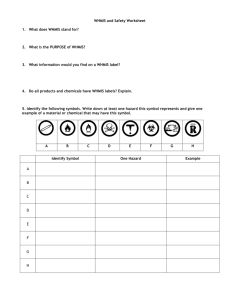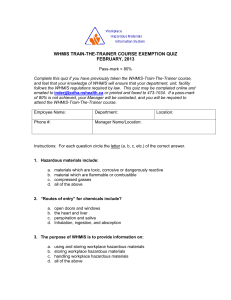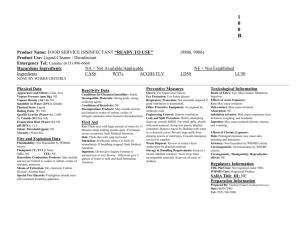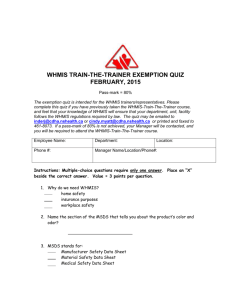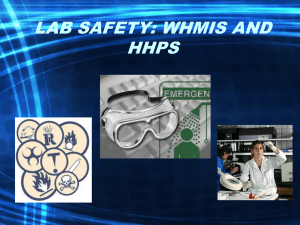whmis: general information & training requirements
advertisement
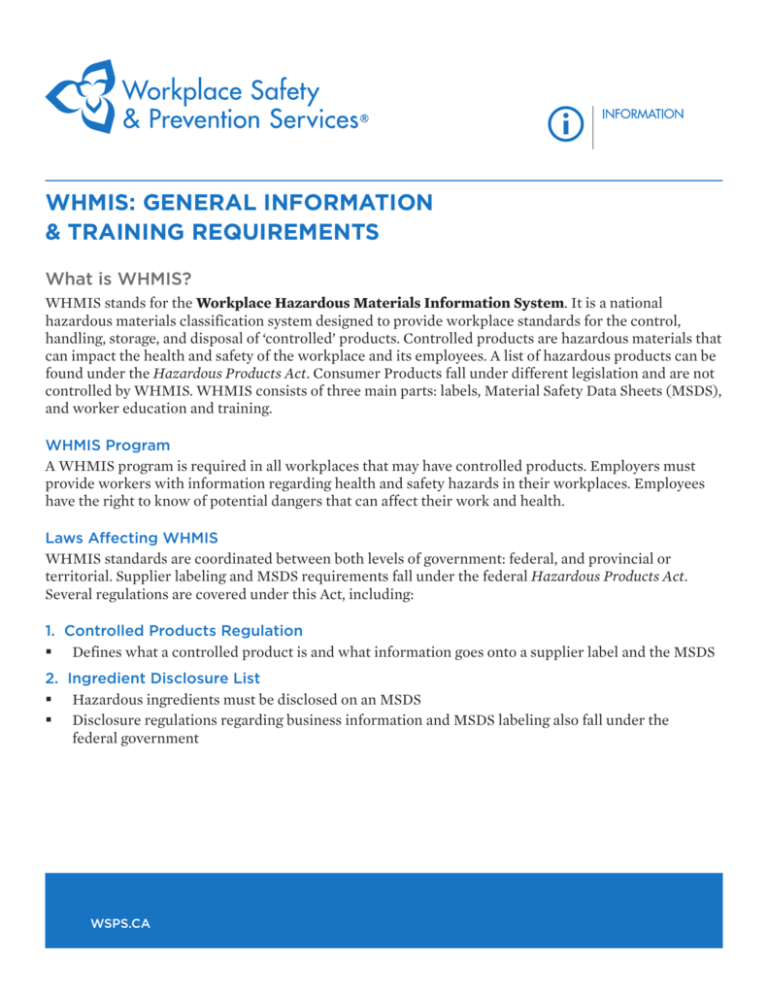
WHMIS: GENERAL INFORMATION & TRAINING REQUIREMENTS What is WHMIS? WHMIS stands for the Workplace Hazardous Materials Information System. It is a national hazardous materials classification system designed to provide workplace standards for the control, handling, storage, and disposal of ‘controlled’ products. Controlled products are hazardous materials that can impact the health and safety of the workplace and its employees. A list of hazardous products can be found under the Hazardous Products Act. Consumer Products fall under different legislation and are not controlled by WHMIS. WHMIS consists of three main parts: labels, Material Safety Data Sheets (MSDS), and worker education and training. WHMIS Program A WHMIS program is required in all workplaces that may have controlled products. Employers must provide workers with information regarding health and safety hazards in their workplaces. Employees have the right to know of potential dangers that can affect their work and health. Laws Affecting WHMIS WHMIS standards are coordinated between both levels of government: federal, and provincial or territorial. Supplier labeling and MSDS requirements fall under the federal Hazardous Products Act. Several regulations are covered under this Act, including: 1. Controlled Products Regulation Defines what a controlled product is and what information goes onto a supplier label and the MSDS 2. Ingredient Disclosure List Hazardous ingredients must be disclosed on an MSDS Disclosure regulations regarding business information and MSDS labeling also fall under the federal government WSPS.CA WHMIS: GENERAL INFORMATION & TRAINING REQUIREMENTS The Hazardous Materials Information Review Act provides legislation that covers issues regarding confidential business information (e.g., Proprietary ingredients), and their disclosure. Regulations under this Act include: 1. Creation of Information Review Commission Rules and exemptions regarding confidential business information disclosure Defines what information suppliers/employers can withhold from labels/MSDSs 2. Hazardous Material Information Review Regulations Criteria for determining claims for exemption, fees for filing claims, and appeals Each province and territory establishes WHMIS employer requirements within its own jurisdiction. In Ontario, these requirements are set out in the WHMIS Regulation 860, which falls under the Occupational Health and Safety Act. The Ministry of Labour (MOL) provides provincial enforcement of the WHMIS Regulation. Controlled Products According to the Workplace Hazardous Materials Information System, Regulation 860, a controlled product is defined as: “…a product, material or substance determined in accordance with Part IV of the Controlled Products Regulations (Canada) to be included in a class listed in Schedule II of the Hazardous Products Act (Canada)” (s.1) A controlled product, therefore, is any product or ingredient that meets the criteria for one or more of the classes of hazards established by WHMIS. The Hazardous Products Act, Schedule I and II, outline what products are covered by the Act, and subsequently, the WHMIS regulations. Section 12 of the Hazardous Products Act states that if a product is controlled by another regulation (e.g., Explosives Act), it does not fall under the WHMIS regulation (they are exempt). If it is bought as a consumer product then it is not covered by WHMIS as it falls under different legislation. Although certain products may not be regulated by WHMIS regulations as far as labeling and MSDS requirements are concerned, there still is an expectation of education of workers on any hazards that may exist with these chemicals. WSPS.CA 2 305-004-02-IGDO © 2013, Workplace Safety & Prevention Services (WSPS) 1 877 494 WSPS (9777) | 905 614 1400 | www.wsps.ca WHMIS: GENERAL INFORMATION & TRAINING REQUIREMENTS Classes of WHMIS CLASS A – Compressed Gas Contents inside the container are under pressure. If the container is damaged, there is a risk of explosion or the product may act as a rocket if dropped. CLASS B – Flammable and Combustible Material Products can ignite, explode or react with other chemicals. There are six divisions under Class B: Division 1: Flammable Gas Division 2: Flammable Liquid Division 3: Combustible Liquid Division 4: Flammable Solid Division 5: Flammable Aerosol Division 6: Reactive Flammable Material CLASS C – Oxidizing Material If this product comes into contact with oxygen or other organic material, it will ignite or explode. WSPS.CA 3 305-004-02-IGDO © 2013, Workplace Safety & Prevention Services (WSPS) 1 877 494 WSPS (9777) | 905 614 1400 | www.wsps.ca WHMIS: GENERAL INFORMATION & TRAINING REQUIREMENTS CLASS D – Poisonous and Infectious Material There are three divisions under Class D: ivision 1: Materials causing immediate and serious D toxic effects A worker can be poisoned or killed if this product enters the body. Division 2: Materials causing other toxic effects Workers may experience chronic health effects from exposure to the material. Subdivision A: Very toxic material Subdivision B: Toxic material Division 3: Biohazardous Infectious Material Worker may become infected with a disease if contact is made with this product. CLASS E – Corrosive material Skin can burn or the worker may experience severe eye and skin irritations. CLASS F – Dangerously reactive material Highly unstable material that can react to other products, heat, light, or WSPS.CA 4 305-004-02-IGDO © 2013, Workplace Safety & Prevention Services (WSPS) 1 877 494 WSPS (9777) | 905 614 1400 | www.wsps.ca WHMIS: GENERAL INFORMATION & TRAINING REQUIREMENTS Labels Supplier and workplace labels are required by WHMIS legislation. Supplier Label The label is created by the supplier and should be affixed to the product container before shipping to a company. According to section 19(1), of the Controlled Products Regulation, seven items must be present on a Supplier Label: 1. Product Name Can be the chemical, common generic or trade name If the name is a trade secret, a code can be used in its place 2. Supplier Name 3. Statement of MSDS Proof of an MSDS sheet with more information 4. Appropriate Hazard Symbol The symbol for the class the product falls into; if it falls into both Division 1 and 2 of class D, then only the symbol for Division 1 is required 5. Risk Phrases Warnings about potential health risks (e.g., eye irritant) 6. Precautionary Measures Safety precautions to be taken when using the product (e.g., face protection) 7. First aid measures First aid procedures until proper medical assistance is available The supplier label must be in English and French and surrounded by a hatched border, in a contrasting colour to the product it is being affixed to. If the supplier places the product into a container that is 100 millilitres or less, then the supplier label only needs to include information from points one to four above [Controlled Products Regulation, s.19(1)]. WSPS.CA 5 305-004-02-IGDO © 2013, Workplace Safety & Prevention Services (WSPS) 1 877 494 WSPS (9777) | 905 614 1400 | www.wsps.ca WHMIS: GENERAL INFORMATION & TRAINING REQUIREMENTS Workplace Label A workplace label is used when the product is being transferred from its original supplier container into a different one. It is also used when the supplier label is illegible, accidentally removed, or the product is produced in the workplace. Workplace labels must contain the following information: 1. Identity of product 2. Safe handling procedures for the product 3. Statement that a MSDS is available Material Safety Data Sheet (MSDS) An MSDS contains storage and handling information for the product. Any controlled product that falls under one of the WHMIS classifications will require an MSDS. According to the Controlled Products Regulation, It must contain nine categories with the following information: 1. Product Information Identifies the product, manufacturer/supplier, and use of the product 2. Hazardous Ingredients Name, concentration, and toxicity of each ingredient Trade secret ingredients do not need to be included on the sheet 3. Physical Data 4. Describes physical properties of the product (e.g., powder vs. solid) 4. Fire/Explosion Hazard Conditions where the product can catch fire or explode 5. Reactivity Data How reactive the product is to other chemicals 6. Toxicological Properties How the product can enter the body (e.g., inhalation, ingestion, absorption) Short and long-term health effects on workers WSPS.CA 6 305-004-02-IGDO © 2013, Workplace Safety & Prevention Services (WSPS) 1 877 494 WSPS (9777) | 905 614 1400 | www.wsps.ca WHMIS: GENERAL INFORMATION & TRAINING REQUIREMENTS 7. Preventive Measures Precautions that should be taken by workers when using this product Product handling precautions during transportation, storage, use, and disposal Emergency procedures 8. First Aid Measures 9. Preparation Information Name and phone number of the person/group who created the MSDS and the date it was created Although in Canada the regulation outlines the above nine categories as what an MSDS should be compiled of, it is commonplace to see a 16 version of an MSDS in Canada – the American standard for an MSDS is a 16 section. This version contains all the information listed above, therefore, is has been allowed as an appropriate layout for an MSDS. Updating MSDSs MSDSs must be updated every three years. According to the Workplace Hazardous Material Information System regulation, section 18(4), if any information on the MSDS changes prior to this, a new sheet must be issued within ninety days. The issue date must be changed and the employer must be notified if there is an updated MSDS. MSDSs must be sent on the first shipment to a workplace. If it is not included, the employer must obtain a copy of the MSDS from the supplier/shipper. The product can be stored, but not used, until a MSDS has been obtained. WHMIS Training Requirements One of the three essential elements of the Workplace Hazardous Materials Information System (WHMIS) is the worker education program. By law, the employer must provide information and instruction to all workers who work with, or near a controlled product (WHMIS Reg. 860, s.6). This means that the employer must provide training to: anyone who stores, handles, uses or disposes of the product; anyone who immediately supervises another worker who performs the above duties; anyone whose health and safety could be at risk during storage, handling, use or disposal of a controlled product; during maintenance activities; or during emergencies such as spills. The employer must also consult with the joint health and safety committee or health and safety representative in the development, implementation, and review of the WHMIS worker education WSPS.CA 7 305-004-02-IGDO © 2013, Workplace Safety & Prevention Services (WSPS) 1 877 494 WSPS (9777) | 905 614 1400 | www.wsps.ca WHMIS: GENERAL INFORMATION & TRAINING REQUIREMENTS program. This program must be reviewed at least once a year, or more often if new information on a controlled product becomes available, or if workplace conditions change (OHSA, s.42). The review is intended to identify whether worker retraining and updating of the education program are necessary This Info Sheet is designed to help your company assess and respond to its training needs, and in doing so, comply with the WHMIS training requirements. Where to Begin Before you can identify employee training needs, you need to first survey your workplace and systems to ensure that all hazardous materials have been identified, and that there are proper controls and procedures in place. The following checklist will help you do that. If you answer “NO” to a question, you have identified a shortcoming that needs to be addressed if your training is to be effective. WSPS.CA 8 305-004-02-IGDO © 2013, Workplace Safety & Prevention Services (WSPS) 1 877 494 WSPS (9777) | 905 614 1400 | www.wsps.ca WHMIS: GENERAL INFORMATION & TRAINING REQUIREMENTS Workplace Checklist 1. Yes No Is there an inventory of all hazardous materials received or produced in your workplace? 2. Are all hazardous materials labeled or identified in accordance with WHMIS requirements (e.g., supplier labels, workplace labels, etc.)? 3. Are labels and other forms of identification clearly visible and in good condition? 4. Are there current MSDSs for every hazardous material received or produced? 5. Are MSDSs complete? 6. Is there a procedure in place to ensure that the requirements for labels and MSDSs are met for all future supplies? 7. Has the workplace been assessed to determine the presence of hazardous materials and typical exposures based on use? 8. Are there proper work practices for the handling, use, storage, and disposal of hazardous materials? 9. Are these practices implemented? 10. Do control systems ensure the safe use of hazardous materials? 11. Are ventilation systems in good working order and regularly maintained? 12. Is personal protective equipment provided where needed? Is equipment worn as required, properly stored, and maintained? 13. Are emergency response procedures in place? Are they prominently posted? 14. Is emergency equipment (fire extinguishers, respirators, eyewash fountains, safety showers, etc.) available and in good working order? 15. A re industrial hygiene facilities (e.g., change rooms, double locker rooms, etc.) provided where needed? 16. Are the storage facilities for hazardous materials adequate? 17. Are the disposal facilities adequate? WSPS.CA 9 305-004-02-IGDO © 2013, Workplace Safety & Prevention Services (WSPS) 1 877 494 WSPS (9777) | 905 614 1400 | www.wsps.ca WHMIS: GENERAL INFORMATION & TRAINING REQUIREMENTS Checklist for Your WHMIS Training Program Once you have assessed your workplace for hazardous materials and suitable controls, you need to turn to your actual training program. Use this checklist to help you assess whether your company is meeting its obligation to provide WHMIS training to workers. Follow up on any “No” answers. Yes 1. No Is training on hazardous materials developed and implemented by the employer, in consultation with the joint health and safety committee or representative? 2. Is the above training and the worker’s familiarity with it reviewed at least once a year in consultation with the joint health and safety committee or representative? 3. Is existing training adequate to ensure continued health and safety on the job? 4. Are workers able to understand the information delivered to them during training? (Literacy and language problems may make it difficult for workers to read and understand training materials, MSDSs, labels, etc.) 5. Are there provisions to train new, transferred, part-time, or casual workers? 6. Are there provisions for refresher training? 7. Are contract employees made aware of health and safety requirements? 8. Are visitors protected? Resources: Workplace Hazardous Materials Information System (WHMIS): A Guide to the Legislation Ontario Ministry of Labour, February 2001 © Workplace Safety and Prevention Services 2013. Workplace Safety and Prevention Services (WSPS) grants permission to approved end users to reproduce this document in whole or in part, provided its intended use is for non-commercial, educational purposes and that full acknowledgement is given to the WSPS. Approved end users are firms registered with the Workplace Safety and Insurance Board. WSPS reserves the right to extend this permission to other stakeholders and interested parties by express written permission upon application. WSPS extends no warranty to materials amended or altered by the end user. Under no circumstances is this document, or any portion thereof, to be duplicated for purposes of sale or for external reproduction or distribution. Revised: March 2011 WSPS.CA 10 305-004-02-IGDO © 2013, Workplace Safety & Prevention Services (WSPS) 1 877 494 WSPS (9777) | 905 614 1400 | www.wsps.ca
